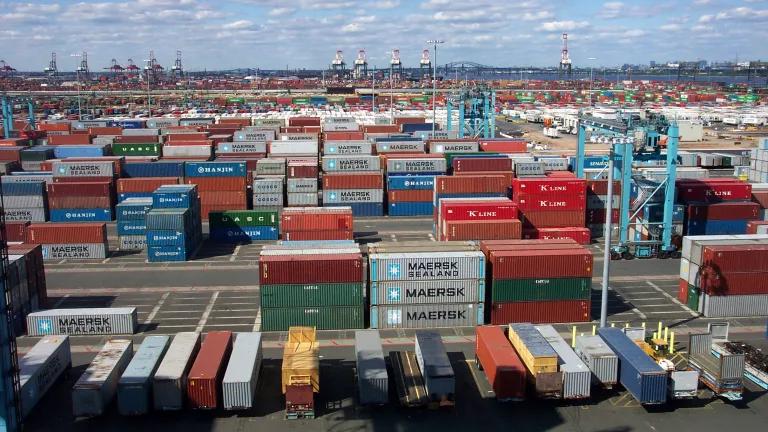Americans Want Sustainable Transportation Options, Not More Highways
Americans prefer sustainable transportation over highways. To deliver, Buttigieg and Governors must repair roads and invest in mobility choices and safety.

Americans want more sustainable transportation choices, not more highways. These are the results of a recent survey on Americans' attitudes toward reducing traffic. The survey revealed strong interest in transportation options that prioritize walkable, bikeable, and transit-connected communities over business-as-usual highway expansions.
An NRDC blog discussed these results and highlighted the mismatch between transportation investments made by state governments and what residents want in terms of reducing traffic. Forty percent of respondents view repairing existing roads or providing more transportation options including trains, buses, bike lanes, and sidewalks as the best long-term solutions for traffic. The good news is that states and the federal government can do a lot to help.
What can states do?
The Bipartisan Infrastructure Law (BIL) provides $643 billion through 2026 to the surface transportation sector and leaves states in the driver’s seat to determine how to use most BIL funds. States play a vital role in directing funds to people’s priorities, e.g., more alternative modes of transportation such as walking, biking and public transportation. To deliver, states can utilize BIL funds in three ways:
- Prioritize repairing existing roads.
According to the survey, road repair and maintenance are understood by Americans to be the most effective long-term solutions for reducing traffic. As such, states must align their investments accordingly. This may include resurfacing roads, fixing potholes, and repairing bridges. Historically, states have used federal infrastructure dollars to expand highways, while repair and maintenance have fallen short. Currently, one-fifth of major roads in the U.S. are in poor condition, and the Federal Highway Administration (FHWA) estimates a $435 billion backlog of rehabilitation needs. So, the popular and climate-smart thing for governors to do is invest in projects that prioritize repairing existing roads.
- Promote public transportation, bike lanes, and sidewalks.
Although it might seem that states are obligated to spend a lot on highways, there’s actually a good deal of flexibility to make more popular, more sustainable choices. Around 70% of BIL funds are distributed to states using a predetermined formula. On average, this formula allocates roughly 82% of funds to highway programs administered by the Federal Highway Administration, while only 18% are allocated to mass transit. The good news is that states have the flexibility to use “highway” dollars for other transportation projects. For example, FHWA’s two biggest highway programs—the Surface Transportation Block Grant Program and the National Highway Performance Program —allow states to use funds for not only road and bridge construction, but also for transit, bike lanes, pedestrian walkways, and highway repair. States should invest in projects that promote public transportation, bike lanes, and pedestrian walkways.
- Funding projects identified in State’s Vulnerable Road User (VRU) Safety Assessment
States can further support their citizens' mobility choices by allocating funding to the projects identified in their Vulnerable Road User (VRU) Safety Assessments. These assessments identify high-risk areas for vulnerable road users and determine safety improvements to reduce these risks. Safer modes of transportation such as transit, biking, and walking work best when people do not have to worry about being killed or injured. Currently, states are completing their VRU Safety Assessments, but there is no requirement for states to fund these projects. Allocating funding to the projects identified in VRU Safety Assessments could improve safety for vulnerable road users and support the development of safer modes of transportation.
What can the Federal Government do?
The federal government also has a number of tools at its disposal. It can encourage states to invest more in alternative modes of transportation by prioritizing equity, sustainability, and safety in federal grant programs. Additionally, the Department of Transportation can provide technical assistance and guidance to states on how to achieve these goals. Finally, federal agencies can publish data on how states are transferring or flexing money. Advocates could then use this information to push for change at the local level, even if the federal government cannot force states to comply.
The FHWA's proposed greenhouse gas (GHG) rule is another promising tool to reduce emissions by helping states better understand the impacts of their transportation investments. Once this rule is finalized, state agencies would be required to measure greenhouse gas emissions related to transportation and set targets for their reduction. Survey results indicate that Americans support sustainable transportation options, which can lead to reduced greenhouse gas emissions. Investing in these options will help states meet the targets they establish for greenhouse gas reduction, while also helping to deliver the kind of mobility options their citizens want.
What does this mean for the climate?
Transportation is the single largest source of national emissions in the U.S. Cars and trucks are the primary culprits. Lowering emissions requires less highway expansion and more alternative modes of transportation. This recent survey echoes these sentiments. As my colleague Rabi states, "[h]ighway expansions are detrimental to people and the environment. Americans recognize that there is a better path forward.” The survey shows that Americans understand that building more highways won’t reduce congestion. Citizens want more sustainable transportation options that prioritize the environment and climate. The infrastructure law provides states and the federal government with a unique opportunity to deliver on these goals. Whether they will do so remains to be seen.



